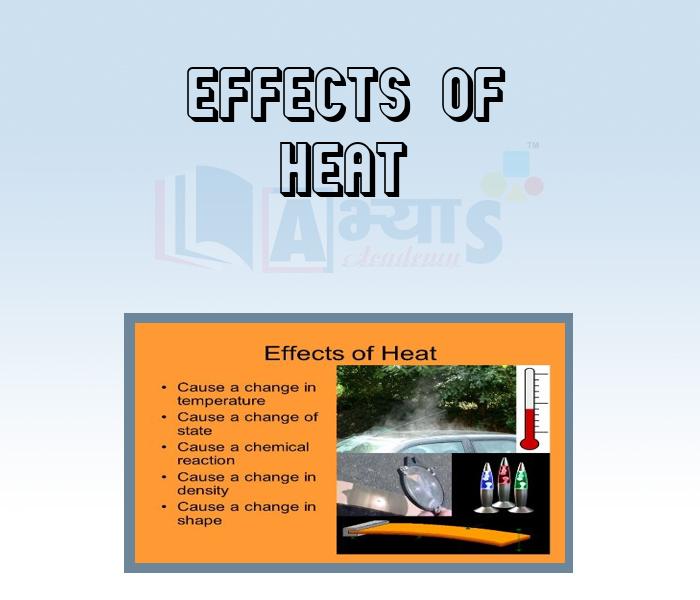Effects of Heat


Effects of Heat
Effects of heat:
Heat Causes Expansion:
When we heat a substance the energy of the molecules increases, they move away a bit more hence they occupy more space. In liquids molecules move more freely than in solids, when they are heated their movements increases more than in solids. A liquid expands more than solid. Similarly, gases expand more than liquids.
Expansion in everyday life:
Temperature Rises With Heat:
As an object is heated it gains energy. The kinetic energy of the molecules increases. This increase in energy of the molecules increases the temperature of the object.
Illustration: When ice is added to water in a glass, why do we feel cold to touch the glass?
Solution: Heat flows from a hot body to cold body. Heat flows out of the glass into the ice. Thus the glass loses heat and hence we feel it cold.
Illustration: An empty bottle is closed tightly with a cork and then heated. After some time the cork shoots out from the mouth of the bottle. What could be the reason?
Solution: When the bottle is heated, the air in it also gets heated and air expands more. Hence it exerts a force on the stopper and causes it to shoot out of the bottle.
Heat always flows _______________ . | |||
| Right Option : B | |||
| View Explanation | |||
In the transmission of electricity ______________________ between poles sag during summer and become tight in winter because of expansion due to heat. | |||
| Right Option : C | |||
| View Explanation | |||
Which of the following are correct ? (a) Heat can burn things which is a physical change . (b) The temperature rises with heat and as an object is heated it gains energy. (c) Excessive heat kills the organisms. | |||
| Right Option : B | |||
| View Explanation | |||
Students / Parents Reviews [10]
Abhyas Methodology is very good. It is based on according to student and each child manages accordingly to its properly. Methodology has improved the abilities of students to shine them in future.

Manish Kumar
10thMy experience was very good with Abhyas academy. I am studying here from 6th class and I am satisfied by its results in my life. I improved a lot here ahead of school syllabus.

Ayan Ghosh
8thIt was good as the experience because as we had come here we had been improved in a such envirnment created here.Extra is taught which is beneficial for future.

Eshan Arora
8thIt was a good experience with Abhyas Academy. I even faced problems in starting but slowly and steadily overcomed. Especially reasoning classes helped me a lot.

Cheshta
10thBeing a parent, I saw my daughter improvement in her studies by seeing a good result in all day to day compititive exam TMO, NSO, IEO etc and as well as studies. I have got a fruitful result from my daughter.

Prisha Gupta
8thAbhyas is a complete education Institute. Here extreme care is taken by teacher with the help of regular exam. Extra classes also conducted by the institute, if the student is weak.

Om Umang
10thI have spent a wonderful time in Abhyas academy. It has made my reasoning more apt, English more stronger and Maths an interesting subject for me. It has given me a habbit of self studying

Yatharthi Sharma
10thOne of the best institutes to develope a child interest in studies.Provides SST and English knowledge also unlike other institutes. Teachers are co operative and friendly online tests andPPT develope practical knowledge also.

Aman Kumar Shrivastava
10thIt has a great methodology. Students here can get analysis to their test quickly.We can learn easily through PPTs and the testing methods are good. We know that where we have to practice

Barkha Arora
10thMy experience with Abhyas is very good. I have learnt many things here like vedic maths and reasoning also. Teachers here first take our doubts and then there are assignments to verify our weak points.
